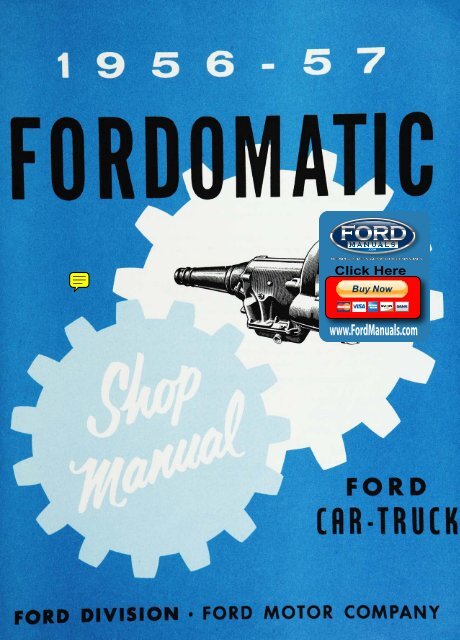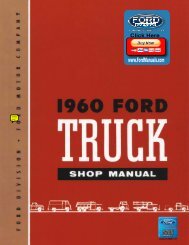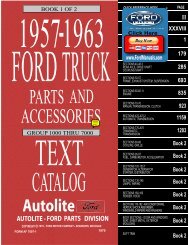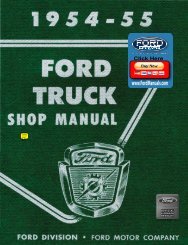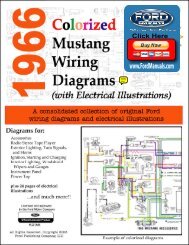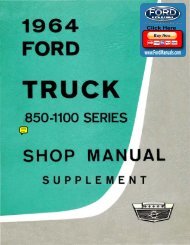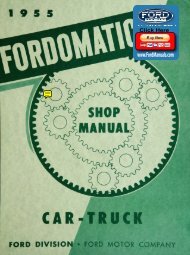DEMO - 1956-57 Fordomatic Car-Truck Shop ... - FordManuals.com
DEMO - 1956-57 Fordomatic Car-Truck Shop ... - FordManuals.com
DEMO - 1956-57 Fordomatic Car-Truck Shop ... - FordManuals.com
- No tags were found...
Create successful ePaper yourself
Turn your PDF publications into a flip-book with our unique Google optimized e-Paper software.
FORDCAR-TRUCKFORD DIVISIONFORD MOTOR COMPANY
Copyright © 2010, Forel Publishing Company, LLC, Woodbridge, VirginiaAll Rights Reserved. No part of this book may be used or reproduced in any manner whatsoeverwithout written permission of Forel Publishing Company, LLC. For information write to ForelPublishing Company, LLC, 3999 Peregrine Ridge Ct., Woodbridge, VA 22192<strong>1956</strong>-<strong>57</strong> <strong>Fordomatic</strong> <strong>Shop</strong> ManualEAN: 978-1-60371-019-0ISBN: 1-60371-019-1Forel Publishing Company, LLC3999 Peregrine Ridge Ct.Woodbridge, VA 22192Email address: webmaster@ForelPublishing.<strong>com</strong>Website: http://www.ForelPublishing.<strong>com</strong>This publication contains material that is reproduced and distributed under a license from FordMotor Company. No further reproduction or distribution of the Ford Motor Company material isallowed without the express written permission of Ford Motor Company.Note from the EditorThis product was created from the original Ford Motor Company’s publication. Every effort hasbeen made to use the original scanned images, however, due to the condition of the material;some pages have been modified to remove imperfections.DisclaimerAlthough every effort was made to ensure the accuracy of this book, no representations orwarranties of any kind are made concerning the accuracy, <strong>com</strong>pleteness or suitability of theinformation, either expressed or implied. As a result, the information contained within this bookshould be used as general information only. The author and Forel Publishing Company, LLCshall have neither liability nor responsibility to any person or entity with respect to any loss ordamage caused, or alleged to be caused, directly or indirectly by the information contained inthis book. Further, the publisher and author are not engaged in rendering legal or otherprofessional services. If legal, mechanical, electrical, or other expert assistance is required, theservices of a <strong>com</strong>petent professional should be sought.
FOREWORDThis manual contains <strong>com</strong>plete service information for all <strong>Fordomatic</strong> transmissionsused in the <strong>1956</strong> and 19<strong>57</strong> Ford <strong>Car</strong>s, Thunderbird,and <strong>Truck</strong>s. All the procedures andspecifications needed to check, adjust, replace, or repair the various parts and assembliesof each transmission and torque converter are included.In many cases, the service procedures are ac<strong>com</strong>panied by illustrations showing theparts and the operations beingperformed. Wherever special tools are needed to servicea unit, illustrations show the use of the tools. Disassembled views of some of the transmission assemblies are also shown to aid in identifyingthe various parts and their relative position in the assemblies.Where new procedures are introduced for the first time on the 19<strong>57</strong> <strong>Fordomatic</strong>, theyalso apply to the <strong>1956</strong> model.The descriptions and specifications contained in this manual were in effect at thetime the book was approved for printing. The Ford Division of Ford Motor Companyreserves the right to discontinue models at any time, or change specifications or design,without notice and without incurring obligation.SERVICE DEPARTMENTFORD DIVISIONFORD MOTOR COMPANY
TABLE OF CONTENTSSubjectPageChapter ONE CONSTRUCTION AND OPERATION 3Section 1 Torque Converter 32 Planetary Gear Train 63 Clutches, Bands and Servos 74 Control System 9Chapter TWO MAINTENANCE AND ADJUSTMENTS 16Section 1 Transmission Fluid 162 Adjustments 17rChapter THREETROUBLE SHOOTING 22Section 1 Preliminary Checks 222 Performance Checks 233 Final Diagnosis 28Chapter FOURREPLACEMENT 30Section 1 Sub-Assemblies Transmission in Vehicle 302 Transmission and Converter 333 Transmission without Converter 35Chapter FIVE TRANSMISSION OVERHAUL 37Section 1 Removal of Sub-Assemblies 372 General Inspection 403 Repair and Assembly of Sub-Assemblies 414 Transmission Case and Linkage 535 Installation of Sub-Assemblies 546 Hydraulic System Tests Transmission on Bench <strong>57</strong>Chapter SIX CONVERTER OVERHAUL 60Section 1 Converter Removal 602 Disassembly 603 Inspection 614 Assembly 625 Installation 63Chapter SEVEN SPECIFICATIONS AND TOOLS 64
Chapter ONECONSTRUCTION AND OPERATIONSection1234Torque Converter 3Planetary Gear Train 6Clutches, Bands, and Servos 7Control System 9Page<strong>Fordomatic</strong> transmissions are available, as optionalequipment, for all <strong>1956</strong> and 19<strong>57</strong> Ford cars, includingthe Police Interceptor Unit, Station Wagons, Courier,Ranchero andThunderbird, and F-100, F-250, F-350,P-350, P-400 and P-500 trucks. The units are basicallythe same as previous <strong>Fordomatic</strong> models. However,changes have been made to <strong>com</strong>pensate for the increasedengine horsepower in <strong>1956</strong> and 19<strong>57</strong> cars and trucks.The <strong>Fordomatic</strong> transmission <strong>com</strong>bines a hydraulictorque converter with a fully-automatic gear system(Fig. 2), and provides a wide range of transmissionratios.The construction details and the principles of operation of the major assemblies in the transmission are described in this chapter. Any <strong>Fordomatic</strong> design or operational differences that may exist among the various carand truck models are also fully explained here.1. TORQUE CONVERTERThe hydraulic torque converters used with all <strong>1956</strong>and 19<strong>57</strong> <strong>Fordomatic</strong> models differ in size. All 6-cylindercars and trucks have an ll3/4-inch converter. All 8-cylinder cars and trucks have a 12-inch converter.a. Construction.case by a one-way clutch which permits the stator torotate onlyin the same direction as the impeller. Theclutch locks the stator to the support on the case toprevent backward rotation.The power from the turbine is transmitted to thetransmission through the turbine shaft.The torque converter consists of three main parts:the impeller (pump), the turbine, and the stator (Fig.1). The impeller is driven bythe engine crankshaftthrough a spring-steel flywheel bolted to the enginecrankshaft. The turbine, which is mounted on a shaft,is driven by the impeller. The stator is mounted on aone-way clutch. All of these parts are enclosed in afluid-filled housingwhich is part of the impeller.b. Operation.The torque converter is designed so that the fluidflows from the impeller to the turbine and back to theimpeller through the stator. This flow produces a maxi-HOUSINGThe impeller, or driving member,consists of curvedblades mounted around the inside of a housingwhich isdriven by the engine. An inner ring locks the blades inplace and forms a fluid passage. As the impeller rotates,fluid is thrown through the curved fluid passage into theturbine.The turbine, or driven member, is similar to the impeller except that it has blades curved in the oppositedirection to the impeller blades. Fluid from the impellerstrikes the turbine blades and causes the turbine andONE-WAYCLUTCHENGINECRANKSHAFTFLUIDTURBINE SHAFTturbine shaft to rotate.byThe fluid leaving the turbine returns to the impellera third set of blades known as the stator. The statoris attached to the stator support on the transmissionfig. 1 Torque Converter Parts5565
Chapter One Construction and OperationSOCOn-oEa>(A
point."Section 1Torque Convertermum torque increase of slightlyover 2:1 when the turCOOLER CONNECTIONSbine is stalled. When enough torque is developed by theengine and converter, the turbine begins to rotate, turning the turbine shaft.The converter torque multiplication gradually tapersoff as turbine speed approaches impeller speed and be<strong>com</strong>es 1:1 when the turbine is being driven at 9/10impeller speed. This is known as the "couplingWhile the turbine is operating at less than 9/10impeller speed and the converter is multiplying torque,the fluid leaving the turbine blades strikes the front faceof the stator blades. These blades are held stationary bythe action of the one-way clutch as long as the fluidis directed against the front face of the blades.When the turbine rotates faster than 9/10 impellerspeed and the converter no longer multiplies torque, thefluid is directed against the back face of the statorblades. As the one-way clutch permits the stator torotate only in the direction of impeller rotation, thestator begins to turn with the impeller and turbine. Theconverter now acts as an efficient fluid coupling as longRADIATOR BOTTOM TANK 3227-AFig. 4 Fluid Line Connection at Radiator 8-Cylinder <strong>Car</strong>as the turbine speed remains greater than 9/10 impellerspeed.The aluminum torque converter used on all 6-cylinderOIL COOLERTO OIL COOLERCONVERTERFRONT PUMPPRESSUREREGULATOR5564TRANSMISSION SUMPTO TRANSMISSION SUMP321 2-AFig. 3Converter Cooling Diagram 6-Cylinder <strong>Car</strong>EngineFig. 5 8-Cylinder <strong>Car</strong> <strong>Fordomatic</strong> CoolingSystem (Schematic)
Chapter One Construction and OperationCOOLANT HOSES(and early <strong>1956</strong> 8-cylinder)shown in Fig. 3.engine is air cooled asOn trucks, the inlet duct is cast into the topof theconverter housing. Fins on the outside of the impellerhousing draw air in through a coarse screen, circulate itover the entire converter surface, and exhaust the airthrough an outlet on the side of the housing.Coolingof the steel torque converter used on all 8-cylinder cars is ac<strong>com</strong>plished by circulating the transmission fluid through an oil-to-water type cooler, locatedin the radiator lower tank as shown in Fig. 4 andschematically in Fig. 5.On truck <strong>Fordomatic</strong> transmissions, except the 6-cylinder F-100, additional cooling is provided by anoil-to-water-type cooler (Fig. 6). Tubes connect theOIL COOLER 3211-AFig. 6O'tl-to-Water-Type Cooler <strong>Truck</strong>cooler with the transmission, and hoses connect thecooler with the engine cooling system.2. PLANETARY GEAR TRAINa. Construction.The <strong>com</strong>pound planetary gear system used in the<strong>Fordomatic</strong> transmission provides neutral, intermediate,high, low, and reverse gear ranges when certain <strong>com</strong>binations of gears are held or driven.The gear train consists of a primary sun gear,secondary sun gear, primary and secondary pinions held ina <strong>com</strong>mon carrier, and an internal gear to which thetransmission output shaft is attached.b. OperationThe operation of the gear train members, held ordriven to provide the various ranges, is described on thefollowing pages.(1) NEUTRAL. When the transmission is in theneutral position, none of the gear train members areheld or driven. Therefore,output shaft (Fig. 7).no power is transmitted to the(2)is ac<strong>com</strong>plished by driving the primaryINTERMEDIATE RANGE. Intermediate rangesun gear andholding the secondary sun gear (Fig. 8). The primarypinions drive the secondary pinions causing them to"walk"around the secondary sun gear carrying theinternal gear and output shaft around with them.(3) HIGH RANGE. In high range, the primary andsecondarysun gears are locked together and driven asa unit (Fig. 9). Therefore,the pinions cannot rotate andthe entire planetary train revolves as a unit, whichcauses the output shaft to rotate at the same speed asthe turbine shaft.(4) LOW RANGE. In low range, the primary sungear is driven and the pinion carrier is held (Fig. 10).Power is transmitted to the primary pinions, the second-FRONTFRONT_BANDCLUTCHREARBANDREAR CLUTCH INTERNAL GEARFRONTCLUTCHAPPLIEDFRONTAPPLIEDBANDSTATIONARYPRIMARY\SUN GEARTURBINESHAFTPRIMARY SUNGEAR SHAFT SECOND/SUN GEARPOWEP FLOWROTATIONSECONDARYPINIONS (3)PRIMARYPINIONS (3)3201-APOWERROTATIONFLOWREAR CLUTCHRELEASEDREAR BANDRELEASED3202-AFig. 7Planetary Gear Train Neutral PositionFig. 8 Power Flow Intermediate Range
Section 2PlanetaryGear TrainFRONT CLUTCHAPPLIEDREAR CLUTCHAPPLIEDFRONT CLUTCHAPPLIEDREARBANDAPPLIEDCARRIERSTATIONARYPOWERROTATIONFLOWFRONT BANDRELEASEDREAR BANDRELEASED3203-APOWERROTATIONFLOWREAR CLUTCH ^ FRONT BANDRELEASEDRELEASED3204-AFig. 9 Power Flow High RangeFig. 10Power Flow Low Rangeary pinions, and the internal gear, driving the internalgear in the same direction as the primary sun gear. TheREARCLUTCHAPPLIEDREARBANDAPPLIEDSTATIONARYsecondarysun gear turns free in the reverse directionand has no effect on the gear train. The pinion carrier isheld against rotation.(5) REVERSE RANGE. Reverse range is ac<strong>com</strong>plished by driving the secondary sun gear and holdingthe pinion carrier (Fig. 11). The secondary pinions drivethe internal gear in the reverse direction. The primarysun gear and the primary pinions rotate freely and haveno effect on the gear train.(6) PARK. When the selector is in the P (park)position, the parking pawl engages the external teeth onthe internal gear to lock the internal gear and outputshaft. This locks the rear wheels to prevent movementPOWERROTATIONFLOWFRONT CLUTCHRELEASEDFRONT BANDRELEASED3205-Aof the vehicle.Fig. II Power Flow Reverse Range3. CLUTCHES, BANDS, AND SERVOSA means of driving and holdingrear clutch drum, rear clutch piston, release spring, fourthe proper parts of(2) REAR CLUTCH. The rear clutch consists of a The rear band fits around the planetary gear assemblythe planetary gear train is required, in order to transmitpower from the turbine and to obtain the various <strong>com</strong>binations required for the gear ratios. This is ac<strong>com</strong>plished by the two multiple disc clutches and the twosingle wrapped bands shown in Fig. 2.steel clutch driven plates, and four clutch drive plateswith bronze facings (Fig. 13). The Thunderbird, PoliceInterceptor, Station Wagons with 312 cu. in. engines, andcars with 8-barrel carburetors have 5 drive and 5 drivenplates in the rear clutch. The rear clutch drive plates area. Construction.(1) FRONT CLUTCH. The front clutch assembly onconnected to the hub of the front clutch drum and thefour driven plates are connected to the drum of thesecondary sun gear. A heavy release spring is used inthe rear clutch assembly.all models consists of the front clutch cylinder, front(3) BANDS. The front and rear bands are made ofclutch piston, release spring, three steel drive plates andsteel and have <strong>com</strong>position linings bonded to the insidefour clutch driven plates with bronze facings (Fig. 12).surfaces. The front band encircles the drum of the secThe drive plates are connected to the turbine shaft. Theondary sun gear assembly. One end of the band isdriven plates are connected to the primary sun gearshaft.anchored in the transmission case and the other end isconnected to the front servo.
8 Chapter One Construction and OperationFRONT CLUTCHb. Operation.FRONT CLUTCHPISTON(1) FRONT CLUTCH. The front clutch is operatedby fluid pressure against the front clutch piston. Thepiston is moved against a spring washer which increasesTURBINESHAFTthe "apply" force through lever action to lock the multiple disc clutch. When the clutch is applied the primarysun gear is locked to the turbine shaft to drive the primary sun gear. The primarysun gear is driven in allFLUIDPRESSUREFig. 12 Front Clutch5589forward speeds. The piston is returned to the releaseposition by the spring washer when the fluid pressure isremoved (Fig. 12).In Neutral, front clutch drum and steel plates arebeing driven while bronze plates are stationary. InReverse, the clutch is not applied but both steel andbronze plates are being driven at engine speed.(2) REAR CLUTCH. The rear clutch is operated byfluid pressure against the rear clutch piston. Movementof the piston <strong>com</strong>presses the release spring and locksdrum. One end of the band contacts the end of the bandadjusting screw and the opposite end is connected to therear servo.(4) FRONT SERVO. The front servo assembly consists of an aluminum servo body, front servopiston, piston guide, release spring, and an actuating lever. Theinner end of the lever contacts the front servo pistonstem and the outer end contacts the front band strut(Fig. 14).(5) REAR SERVO. The rear servo assembly consistsof a cast aluminum servo body, rear servo piston, accuthe multiple disc clutch. The rear clutch drive platesare splined to the front clutch drum and the drivenplates are connected to the secondary sun gear. Whenthe rear clutch is applied (in the reverse and in thedrive range high ratios) the secondary sun gear is driven.The piston is returned to the released position by therear clutch release spring (Fig. 13).In Neutral, rear clutch bronze plates are being drivenwhile steel plates are free. In Intermediate,rear clutchbronze plates are driven, but steel plates are held stationary. In Low, rear clutch bronze plates are drivenclockwise at engine speed while steel plates are drivenmulator piston spring, accumulator piston,rear servo recounterclockwise.lease spring, and an actuating lever. The inner end ofthe actuating lever contacts the accumulator piston andthe outer end engages one end of the rear band strut.(Fig. 15.)FRONTCLUTCHPISTON(3) BANDS. The front band encircles the drum ofthe secondary sun gear assembly. One end of the bandis anchored against a boss in the transmission case.The opposite end of the band engages a strut betweenthe band and front servo actuating lever. When theFRONT BANDFRONT SERVOFRONTCLUTCH- FLUIDFLUIDPRESSUREPRESSURE5590APPLY-Fig. 13Rear ClutchFig. 14Front Servo Operation
Section 3 Clutches, Bands, and ServosREAR BANDREAR SERVO(4)FRONT SERVO. The front servo piston ismoved by fluid pressure which exerts force against theinner end of the front servo actuating lever. Force istransmitted through a strut between the outer end ofthe lever and the end of the band to tighten the frontband around the drum. Under certain conditions, theservo is released by directing fluid pressure to the opposite side of the piston, assisted by release spring force(Fig. 14).(5) REAR SERVO. The rear servo assemblyuses anaccumulator piston and spring to cushion application ofAPPLYthe rear band. Fluid pressure is directed to the rear servopiston to force it inward. When the band contacts thedrum, cushioning is provided as the accumulator pistonspring is <strong>com</strong>pressed. As the accumulator piston bottomsFig. 15Rear Servo Operation5580in the rear servo piston bore, the rear band is fullyapplied (Fig. 15).The clutches and bands are applied by pressure fromband is held tightly around the drum, it prevents thesecondary sun gear from turning. The front band isapplied in the intermediate ratio.The rear band is placed around a drum attached tothe hydraulic control system in the following <strong>com</strong>binations to obtain the desired gear ranges:RatioApplyNeutralNo Clutches or Bandsthe pinion carrier. One end of the rear band contacts astrut on the inner end of the rear band adjusting screw.The other end of the band engages the strut between theband and the rear servo actuating lever. The rear bandis applied in the low and reverse ratios.Intermediate (1.47:1)High (1:1)Low (2.40:1)Reverse (2:1)Front Clutch-Front BandFront Clutch-Rear ClutchFront Clutch-Rear BandRear Clutch Rear Band4. CONTROL SYSTEMsion operation to engine torque and driver preference,Several fluid pressures, which vary with throttle open(2) THROTTLE PRESSURE. To adjust transmis (engine torque).ing, road speed or manual selector position, are used inthe transmission control system. These fluid pressuresand their operation under various driving conditions areexplained in this section.throttle pressure is used in the control system.Throttle pressure is produced from control pressureby the throttle valve and is controlled by the <strong>com</strong>pression on the throttle valve spring. Compression on thethrottle valve spring is controlled by accelerator pedala. Fluid Pressures.(1) PRESSURE SOURCE. Two pumps (Fig. 17)deliver fluid pressure to the transmission control system.The front pump, driven by the converter impeller, operates whenever the engine runs. The rear pump, drivenby the transmission output shaft, delivers fluid to thecontrol system, when the vehicle moves forward.The front pump has a greater capacity than the rearpump, since it must supply all the fluid to operate thetransmission at low speeds and in reverse.Both pumps deliver fluid pressure to the control pressure regulator and control valve body (Fig. 17). A regudepression.Throttle pressure will vary from zero (at closed throttle) to the same pressure as maximum control pressure(at wide-open throttle), as shown in Figs. 16 and 19.Throttle pressure is directed to the 2-3 valve andplug to oppose governor pressure, and therebyvary the 2-3 shift according to accelerator pedal depression.Throttle pressure is also directed to the orifice controlvalve to position it for two 3-2 downshift conditionsa downshift with closed throttle; a downshift with partial to full throttle.lated pressure, called control pressure, is available at(3) MODULATED THROTTLE PRESSURE. Inthe control valve bodywhenever the engine is runningor the vehicle is moving forward above approximately15 m.p.h.Dr (drive) and Lo a(low)modulated throttle pressure17) is directed to the <strong>com</strong>pensator valve to adjust<strong>com</strong>pensator pressure to accelerator pedal depression
10 Chapter One Construction and OperationIn R (reverse) full throttle pressure is directed to twofaces on the <strong>com</strong>pensator valve to reduce <strong>com</strong>pensatorpressure, and thereby increase control pressure (Fig. 21).At 9V2 to 12 transmission throttle lever advance inR (reverse), <strong>com</strong>pensator pressure is reduced to zero,andtherebymaximum control pressure is produced.Maximum control pressure is not required or desirable in Dr (drive) or Lo (low); hence, throttle pressure in these ranges is directed to the modulator valvebefore it acts on one face of the <strong>com</strong>pensator valve(Fig. 17).The modulator valve has a spring of fixed length, andtherefore fixed <strong>com</strong>pression, attached to it. In operationthe modulator valve permits throttle pressure to flowthrough it without a pressure reduction until throttlepressure reaches approximately 52 p.s.i. At this pressure,the modulator valve is balanced; hence, modulatorpressure cannot exceed approximately 52 p.s.i.(4)SHIFT VALVE PLUG PRESSURE. Beforethrottle pressure is admitted to the front facet of the 2-3shift valve and the governor plug, it must open a passage past the spring-loaded shift valveplug (Fig. 17).Approximately 20 p.s.i. throttle pressure is required tomove the plug against its spring far enough to open thepassage; hence, the pressure past the plug is reduced.(5)GOVERNOR PRESSURE. Governor pressure isproduced from control pressure by the governor valveoperating in the governor body. The governor bodyrotates at output shaft speed.The governor valve is a balanced valve: governorpressure actingon a valve face balances centrifugalforce acting on the valve. Governor pressure is therefore,proportional to road speed.Governor pressure is directed to the 2-3 shift valve,the 1-2shift valve (inhibitor), and the <strong>com</strong>pensatorvalve (Figs. 17 and 19).(6) CONTROL PRESSURE AND COMPENSATORPRESSURE. In the transmission, control pressure isadjusted to engine torque, road speed and selector leverposition.To ac<strong>com</strong>plish this,<strong>com</strong>pensator pressure under various conditions is adjusted by throttle pressure (enginetorque), governor pressure (road speed), or selectorlever position. Compensator pressure, in turn, adjustscontrol pressure.Basically, <strong>com</strong>pensator pressure is regulated by the<strong>com</strong>pensator valve spring. For example, with the engineidling (no throttle pressure) and the vehicle standingstill (no governor pressure), <strong>com</strong>pensator pressure isregulated only by the <strong>com</strong>pensator valve spring. If theFRONTPUMP ACONTROL PRESSURE|REGULATOR VALVE^H CONTROL PRESSUREDRIVE RANGELOW AND REVERSE RANGECONVERTERDRIVE RANGELOW AND REVERSE RANGEi PUMP INTAKE PRESSURECOMPENSATOR PRESSUREOIL COOLER ^COMPENSATOR L^-COMPENSATOR ^COMPENSATORPLUG VALVE CUT-BACKI 1 VENTLUBRICATINGX EXHAUST TO SUMPFig. 16Control Diagram Neutral Ratio3592
Section 4 Control System 11driver depresses the accelerator to drive off, throttlepressure (or modulated pressure) acting on a face of the<strong>com</strong>pensator valve assists <strong>com</strong>pensator pressure againstthe <strong>com</strong>pensator valve spring. This assistance reduces<strong>com</strong>pensator pressure, and thereby increases controlpressure. This is so, because control pressure is assisted,in alldriving conditions (except reverse at and beyond9V2to 12 throttle lever advance), by <strong>com</strong>pensatorpressure in opposition to the control pressure regulatorvalve spring.Governor pressure which starts and increases withroad speed, acts on the <strong>com</strong>pensator plug (Fig. 17) andassists the <strong>com</strong>pensator valve spring, which is opposing<strong>com</strong>pensator pressure. Governor pressure, therefore,causes an increase in <strong>com</strong>pensator pressure, and therebya decrease in control pressure.At approximately 30 m.p.h., governor pressure actingon the cut-back valve end face is high enough to over<strong>com</strong>e the control pressure force in the cut-back valvevalley. Above approximately 30 m.p.h., therefore, governor pressure is acting at both ends of the <strong>com</strong>pensatorvalve and the <strong>com</strong>pensator pressure increase,which wascaused by governor pressure acting on the <strong>com</strong>pensatorback."plug only, is "cutFor example, control pressure on a 6-cylinder vehicleduring a full-throttle acceleration from standing to 65m.p.h. varies with road speed as follows:Control pressure at the start (full-throttle)will be124-144 p.s.i. Control pressure at about 30 m.p.h. willbe 87-100 p.s.i. The decrease in pressure (from standingat full-throttle) is caused by governor pressure acting onthe <strong>com</strong>pensator plug only. Up to about 30 m.p.h., governor pressure force on the cut-back valve is locked outby control pressure actingon the cut-back valve.At about 65 m.p.h.(full-throttle)control pressurewill be 77-90 p.s.i. Although governor pressure is actingat both ends of the <strong>com</strong>pensator valve above 30 m.p.h.,the <strong>com</strong>pensator plug diameter is slightly larger thanthe cut-back valve diameter. Therefore, an increase ingovernor pressure causes a slight increase in <strong>com</strong>pensatorpressure, with a consequent decrease in control pressure.Above approximately 65 m.p.h. control pressure willnot change with road speed, because governor pressureis maximum (equal to control pressure).On other <strong>Fordomatic</strong> models, control pressure is higher, but follows the same general pattern.(7) CONVERTER PRESSURE. Like control pressure, converter pressure is regulated by the converterpressure regulator valve spring and is adjusted to drivingconditions by <strong>com</strong>pensator pressure. Converter pressurerange is approximately 15 p.s.i. to 60 p.s.i.REARPUMPI CONTROL PRESSUREi CONVERTERI PUMP INTAKE PRESSUREMODULATOR PRESSUREOIL COOLER ^COMPENSATOR LcOMPENSATOR ^-COMPENSATORPLUG VALVE CUT-BACKI I THROTTLE PRESSURE1GOVERNOR PRESSUREH) LUBRICATINGI I SHIFT VALVE PLUG PRESSUREI I VENTXEXHAUST TO SUMPFig. 17 Control Diagram Intermediate Ratio5593
12 Chapter One Construction and Operationb. Special Valves.Several valves in the control system have been designed to meet specific conditions in the transmission'soperation.(1) ORIFICE CONTROL VALVE. The orifice control valve is positioned in a bore in the control valveassembly by a spring. Duringa normal high to intermediate shift with closed throttle, smooth front bandapplication is provided by exhausting the front servorelease fluid through a small orifice. When the sameshift occurs at openthrottle, the orifice control valve,positioned by throttle pressure, permits an unrestrictedexhaust of front servo release pressure, providing a rapidfront band application.On a manual shift from intermediate to low at closedthrottle, the orifice control valve momentarily restrictsthe fluid flow applying the rear servo and releasing thefront servo. This action provides a smooth rear bandengagement.(2)DOWNSHIFT VALVE. The downshift valve ispositioned in the control valve body bore with the throttle valve. The inner throttle lever contacts one end ofthe downshift valve and the inner end contacts thedownshift valve spring. Control pressure is directed toa land of the valve. Linkage is connected between theaccelerator pedal and throttle lever. The downshift valveis moved to open a passage to direct fluid pressure to theback face of the 2-3 shift valve and the 2-1 shift valve,when the accelerator pedal is depressed through thedetent.(3)TRANSITION VALVE. The transition valve ispositioned in a bore in the control valve body by aspring. The function of this valve is to time the operation of the front servo in relation to the rear servo.Fluid flow to apply the rear band is blocked by thetransition valve until the flow to release the front bandhas built up enough pressure to open the transition valveagainst its spring.When the rear band is released, the fluid is exhaustedslowly by the action of the rear servo check valve orifice until front servo release pressure is exhausted. Withfront servo release pressure gone, the transition valve ismoved by its spring and provides an unrestricted exhaust for the rear servo fluid.(4) LOW INHIBITOR VALVE. The low inhibitorvalve is a part of the control valve assembly. This valveprevents a shift into low above approximately 25 m.p.h.A spring at one end of the valve holds it in a closedposition. Passages are provided at both ends of thevalve. Governor pressure is directed to the end of theREARPUMPOIL COOLER ^-COMPENSATOR ^-COMPENSATOR ^-COMPENSATORPLUG VALVE CUT-BACKFig. 18Control Diagram High RatiotU CONTROL PRESSUREi CONVERTEROIL SCREEN EM PUMP INTAKE PRESSURESS COMPENSATORI MODULATOR PRESSUREI I THROTTLE PRESSUREPRESSUREH GOVERNOR PRESSURE[UL LUBRICATINGI I VENTXEXHAUST TO SUMP5S94
Section 4 Control System 13valve opposite the spring, and fluid pressure from themanual valve is directed to one of the lands. The valveis moved against the spring when the vehicle speed increases to produce enough governor pressure to over<strong>com</strong>e the spring force, and causes the shift from low tointermediate.c. Operation.The automatic operation of the transmission is provided by controlling the flow of fluid pressure to the<strong>com</strong>ponents. Fluid flow needed to operate the <strong>com</strong>ponents and to provide the different ratios is explainedhere. Control diagrams for all the ratios are given onthe following pages.pressure regulator valve (assisted by<strong>com</strong>pensator pressure) has moved against its spring and is delivering fluidto the converter input passage.The converter has been filled and is at normal pressure. Therefore, the converter pressure regulator valvehas moved against its spring and has opened a passagefor fluid to flow to the transmission lubrication system.(2)DRIVE RANGE INTERMEDIATE RATIO.(Fig. 17). When the selector lever is moved from theN (neutral) position to Dr (drive),the manual valvemoves to open passages from the manual valve to thefront clutch and governor, the apply side of the frontservo, and to the 2-1 and 2-3 shift valves. Control pressure to the front clutch locks the primarysun gear to(1) NEUTRAL RANGE (Fig. 16). With the enginethe turbine shaft. Control pressure to the applyside ofrunning, the front pump is delivering fluid to the control pressure regulator, manual, downshift, throttle, <strong>com</strong>pensator and <strong>com</strong>pensator cut-back valves.The manual valve in N (neutral)position blocks thefluid flow to both clutches and both bands. With no fluidpressure in the clutches or servos, both clutches andbands are released by spring pressure and drive throughthe transmission is impossible.The front pump is delivering more fluid than is necessary to maintain control pressure; hence, the controlthe front servo applies the front band to hold the secondary sun gear. The 2-1 and 2-3 shift valves are heldin the closed position by the shift valve springs, andcontrol pressure is blocked at the shift valve lands. Withthe primary sun gear driven and the secondary sun gearheld, the transmission operates in the intermediate ratioof 1.47 to 1.(3)DRIVE RANGE-HIGH RATIO (Fig. 18). Theshift from the intermediate to the high ratio is ac<strong>com</strong>plished when the front servo is released and the rear-COMPENSATORPLUG-COMPENSATORVALVEREAR PUMPCONTROL PRESSURECONVERTERPUMP INTAKE PRESSURECOMPENSATOR PRESSUREBl MODULATOR PRESSUREBl GOVERNOR PRESSUREODDI I VENTLUBRICATINGX EXHAUST TO SUMPSS9SFig. 19Control Diagram Low Ratio (Selector in Dr)
14 Chapter One Construction and Operationclutch is applied. This is ac<strong>com</strong>plished by directing governor pressure to a face of the 2-3 shift valve and to thegovernor plug. As the shift valve moves inward, passagesare uncovered to direct control pressure to the releaseside of the front servo and to the rear clutch. When bothclutches are applied, the primary and secondary sungears are locked to the turbine shaft to provide the highratio of 1 to 1.A centrifugally-operated governor is used to provideautomatic shifts from the intermediate to the high ratio.Control pressure from the manual valve is directedagainst a face of the governor valve. The governorvalve is forced outward by centrifugal force as the outputshaft begins to rotate. Control pressure is reduced andis regulated in direct proportion to the vehicle speed.When enough governor pressure is provided against theshift valve to over<strong>com</strong>e the springs, the shift valvemoves inward to uncover the passages to the releaseside of the front servo and to the rear clutch.(4) DRIVE RANGE-LOW RATIO (Fig. 19).When the accelerator pedal is depressed beyond thedetent (forced down-shift)below 16 m.p.h. the downshift valve directs control pressure to close the 2-3shift valve and open the 2-1 valve.At the same time, control pressure starts to flowthrough the 2-1 valve to apply the rear band and release the front band. With the front clutch applied, thefront band released, and the rear band applied, thetransmission is in the low ratio.Forced downshifts to the low ratio above 16 m.p.h.are prevented by the 1-2closed by(inhibitor) valve, which isgovernor pressure at this speed in high andintermediate ratios.Upshifts from the drive range low ratio are ac<strong>com</strong>plished automatically. Governor pressure against theend of the low inhibitor valve increases with vehiclespeed. At approximately 28-34 m.p.h., governor pressureis high enough to move the low inhibitor valve inwardto cut off rear servo apply and front servo release pressure. The front band is then applied by front servo applypressure, and the transmission shifts from the low to theintermediate ratio.(5) LOW RANGE (Fig. 20). In the Lo (low) range,control pressure isdirected to the front clutch andgovernor, to the apply side of the front servo and tothe 2-1 shift valve, and through the downshift valve tothe ends of the shift valves. Control pressure directedto the end of the 2-1 shift valve moves it against springpressure. A passage is opened from the 2-1 shift valve,through the closed 2-3 shift valve, and orifice control..U CONTROL PRESSUREOIL COOLERL COMPENSATORPLUG-COMPENSATORVALVE^- COMPENSATORCUT-BACKI CONVERTERI PUMP INTAKE PRESSUREBl COMPENSATOR PRESSUREfll MODULATOR PRESSUREI I THROTTLE PRESSUREBl GOVERNOR PRESSUREflT LUBRICATINGI I VENTXEXHAUST TO SUMPS596Fig. 20 Control Diagram Low Ratio (Selector in Lo)
Section 4 Control System 15valve to the release side of the front servo. At the sametime, control pressure is directed to the rear servo toapply the band.Upshifts from the low range are prevented by controlpressure, from the manual valve, directed to the springend of the low inhibitor valve. Governor pressure on theend of the valve is insufficient to move the valve againstopposing control pressure. As long as front band releaseand rear clutch apply pressures are present, upshifts areprevented.(6)REVERSE RANGE (Fig. 21). Control pressure to the front clutch is cut off at the manual valve.Control pressure from the manual valve is directed tothe apply side of the front servo, and through the 2-1shift valve, 2-3 shift valve and orifice control valve tothe release side of the front servo and to apply the rearservo. Control pressure from the manual valve is alsodirected to the rear clutch. With the rear band and rearclutch applied, the transmission operates in the reverseratio of 2 to 1.REAR PUMP \\OIL COOLER f-COMPENSATOR '-COMPENSATOR ^COMPENSATORPLUG VALVE CUT-BACK^M CONTROL PRESSUREIB CONVERTERI PUMP INTAKE PRESSUREBl COMPENSATOR PRESSUREI I THROTTLE PRESSUREHD LUBRICATINGI I VENTI I EXHAUST TO SUMP5597Fig. 21 Control Diagram Reverse Ratio


